-
![[幼儿园大班主题教案]有趣的墨迹图](https://www.lfppt.com/PPT_IMG/2022-11/30/202211301635078606648d6c774824be74ebc3730d61a7.png)
[幼儿园大班主题教案]有趣的墨迹图
二、活动准备 1、教师曾示范制作墨迹图,以引起幼儿操作和想像的兴趣。 2、白纸、颜色水、辅助物、铺垫的桌布。三、活动过程 1、自制墨迹图,引起幼儿兴趣。 (1)、回忆墨迹图制作的方法。 (2)、提出制作墨迹图应注意的事项。 (3)、幼儿自制墨迹图,教师巡回指导。
![[幼儿园大班主题教案]线的分类、统计](https://www.lfppt.com/PPT_IMG/2022-11/30/20221130163229ef36d025abc142de98a5f337dc52f364.png)
[幼儿园大班主题教案]线的分类、统计
二、使用对象及场所:大班幼儿在幼儿院进行。三、活动目标1、在观察、比较、讨论中,对线进行颜色、粗细、质地、长短的分类。2、教师和标记的引导下,学习自己设计简单的统计表。3、语言表达操作的情况,使幼儿的语言和思维同步得到发展。四、活动准备1、各种各样的线若干。2、纸、笔每人一份。3、统计示范图。
![[幼儿园大班主题教案]我喜欢的成语](https://www.lfppt.com/PPT_IMG/2022-11/30/202211301643251f3d78643dc34b21a5da7b1b963f227e.png)
[幼儿园大班主题教案]我喜欢的成语
二、主题网络 丰富词汇 增长知识与才智 言简意赅 动物类谈话绘画制作表演 作 用 数字类 我喜欢的成语 成 语 种 类 同字类 表征活动 寓意相同类 我制作的成语邮票 凿壁借光 囊莹映雪 悬梁刺股 向他们学习三、关键经验1、知道汉语成语是中华民族瑰宝,能关注生活中使用的成语,激发喜爱成语的积极情感。2、了解汉语成语的种类、作用,体验其精炼明快、言简意赅的特点。3、愿意运用多种方式(讲、画、制作、表演)创造性地表现喜欢的成语。4、能运用调查、查阅、交流等方法进行探索学习。
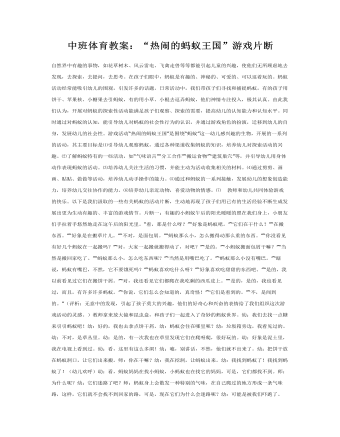
中班体育教案:“热闹的蚂蚁王国”游戏片断
其主要目标是⑴引导幼儿观察蚂蚁,通过各种渠道收集蚂蚁的知识,培养幼儿对探索活动的兴趣。⑵了解蚂蚁特有的一些活动,如“气味语言”“分工合作”“搬运食物”“建筑巢穴”等,并引导幼儿用身体动作表现蚂蚁的活动。⑶培养幼儿关注生活的习惯,并能主动为活动收集相关的材料。⑷通过剪剪、画画、贴贴、做做等活动,培养幼儿动手操作的能力。⑸通过和蚂蚁的一系列接触,发展幼儿的想象创造能力,培养幼儿交往协作的能力。⑹培养幼儿亲近动物,喜爱动物的情感。⑺ 教师和幼儿共同体验游戏的快乐。以下是我们汲取的一些有关蚂蚁的活动片断,生动地再现了孩子们用已有的生活经验不断生成发展出更为生动有趣的、丰富的游戏情节。片断一:有趣的小蚂蚁午后的阳光暖暖的照在我们身上,小朋友们手拉着手悠然地走在这午后的阳光里。“看,那是什么呀?”“好象是蚂蚁吧。”“它们在干什么?”“在搬东西。”“好象是在搬草片儿。”“不对,是面包屑。”“蚂蚁那么小,怎么搬得动那么重的东西。”“你没看见有好几个蚂蚁在一起搬吗?”“对,大家一起搬就搬得动了,对吧?”“是的。”“小蚂蚁搬面包屑干嘛?”“当然是搬回家吃了。”“蚂蚁那么小,怎么吃东西呢?”“当然是用嘴巴吃了。”“蚂蚁那么小没有嘴巴。”“瞎说,蚂蚁有嘴巴,不然,它不要饿死吗?”“蚂蚁喜欢吃什么呀?”“好象喜欢吃甜甜的东西吧。”“是的,我以前看见过它们在搬饼干屑。”“对,我还看见它们都爬在我吃剩的西瓜皮上。”“是的,是的,我也看见过,而且,有许多许多蚂蚁。”“你说,它们怎么会知道的,真奇怪!”“它们是看到的。”“不,是闻到的。”(评析:无意中的发现,引起了孩子莫大的兴趣,他们的好奇心和兴奋的表情给了我们组织这次游戏活动的灵感。)教师拿来放大镜和昆虫盒,和孩子们一起进入了奇妙的蚂蚁世界。幼:我们去找一点糖来引引蚂蚁吧!幼:好的,我也去拿点饼干屑。幼:蚂蚁会住在哪里呢?幼:垃圾箱旁边,我看见过的。幼:不对,是草丛里。幼:是的,有一次我也在草里发现它们在爬呀爬,很好玩的。幼:好象是泥土里,我在电视上看到过。幼:看,这里有这么多洞!幼:嘘,别讲话,不然,他们就不出来了。幼:把饼干放在蚂蚁洞口,让它们出来搬。师:你在干嘛?幼:我在挖洞,让蚂蚁出来。
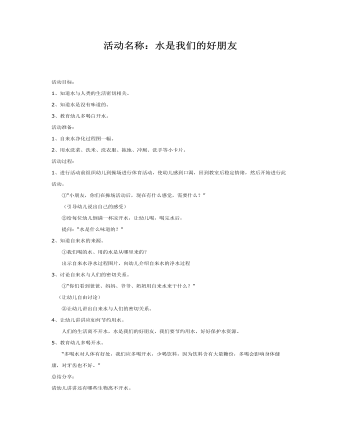
中班综合教案大家都离不开的朋友——水
2、知道水是没有味道的。 3、教育幼儿多喝白开水。 活动准备: 1、自来水净化过程图一幅。 2、用水洗菜、洗米、洗衣服、拖地、冲厕、洗手等小卡片。 活动过程: 1、进行活动前组织幼儿到操场进行体育活动,使幼儿感到口渴,回到教室后稳定情绪,然后开始进行此活动。 ①“小朋友,你们在操场活动后,现在有什么感觉,需要什么?” (引导幼儿说出自己的感受) ②给每位幼儿倒满一杯凉开水,让幼儿喝,喝完水后, 提问:“水是什么味道的?” 2、知道自来水的来源。 ①我们喝的水、用的水是从哪里来的? 出示自来水净水过程图片,向幼儿介绍自来水的净水过程
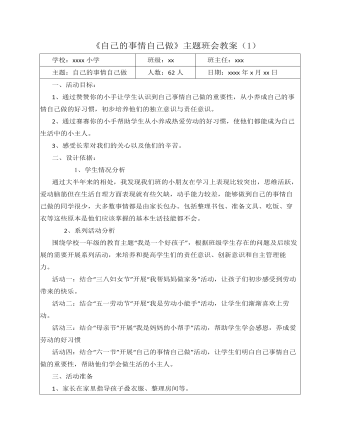
《自己的事情自己做》主题班会教案(1)
一、活动目标:1、通过赞赞你的小手让学生认识到自己事情自己做的重要性,从小养成自己的事情自己做的好习惯,初步培养他们的独立意识与责任意识。2、通过赛赛你的小手帮助学生从小养成热爱劳动的好习惯,使他们都能成为自己生活中的小主人。3、感受长辈对我们的关心以及他们的辛苦。二、设计依据:1、学生情况分析通过大半年来的相处,我发现我们班的小朋友在学习上表现比较突出,思维活跃,爱动脑筋但在生活自理方面表现就有些欠缺,动手能力较差,能够做到自己的事情自己做的同学很少,大多数事情都是由家长包办。包括整理书包、准备文具、吃饭、穿衣等这些原本是他们应该掌握的基本生活技能都不会。
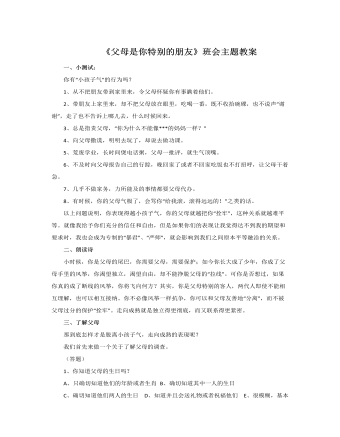
《父母是你特别的朋友》主题班会教案
7、几乎不做家务,力所能及的事情都要父母代办。8、有时候,你的父母气极了,会骂你“给我滚,滚得远远的!”之类的话。以上问题说明,你表现得越小孩子气,你的父母就越把你“拴牢”,这种关系就越难平等。就像我给予你们充分的信任和自由,但是如果你们的表现让我觉得达不到我的期望和要求时,我也会成为专制的“暴君”、“严师”,就会影响到我们之间原本平等融洽的关系。二、朗读诗 小时候,你是父母的尾巴,你需要父母,需要保护;如今你长大成了少年,你成了父母手里的风筝,你渴望独立,渴望自由,却不能挣脱父母的“拉线”。可你是否想过,如果你真的成了断线的风筝,你将飞向何方?其实,你是父母特别的客人,两代人即使不能相互理解,也可以相互接纳。你不必像风筝一样抗争,你可以和父母友善地“分离”,而不被父母过分的保护“拴牢”。走向成熟就是独立得更彻底,而又联系得更紧密。
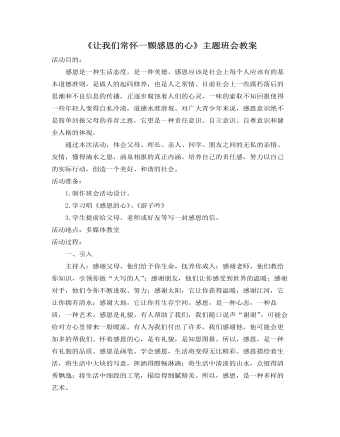
《让我们常怀一颗感恩的心》主题班会教案
一、引入 主持人:感谢父母,他们给予你生命,抚养你成人;感谢老师,他们教给你知识,引领你做“大写的人”;感谢朋友,他们让你感受到世界的温暖;感谢对手,他们令你不断进取、努力;感谢太阳,它让你获得温暖;感谢江河,它让你拥有清水;感谢大地,它让你有生存空间。感恩,是一种心态,一种品质,一种艺术。感恩是礼貌。有人帮助了我们,我们随口说声“谢谢”,可能会给对方心里带来一股暖流。有人为我们付出了许多,我们感谢他,他可能会更加多的帮我们。怀着感恩的心,是有礼貌,是知恩图报。所以,感恩,是一种有礼貌的品质。感恩是画笔。学会感恩,生活将变得无比精彩。感恩描绘着生活,将生活中大块的写意,挥洒得酣畅淋漓;将生活中清淡的山水,点缀得清秀飘逸;将生活中细致的工笔,描绘得细腻精美。所以,感恩,是一种多样的艺术。下面我宣布“让我们都有一颗感恩的心”主题班会现在开始!
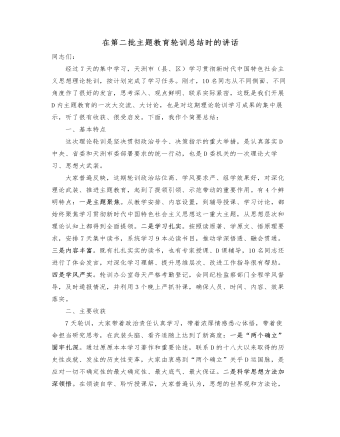
在第二批主题教育轮训总结时的讲话
要分类推进,对能改的问题马上改,一时解决不了的要明确具体整改措施和时限,需要长期解决的要划分阶段明确整改目标,紧盯不放、阶梯推进。要联动推进,第一批、第二批主题教育中,有些问题需要机关和基层上下联动共同解决,各负责单位要加强沟通联系,指导下级不等不拖先动起来。同时,对基层反映的问题要积极接纳、主动认领,确保问题解决形成“回路”、形成合力。(四)严抓指导督导。第二批主题教育展开,D委机关必须走在前列、做好表率,为基层立好样板。要力度不减严抓本级,结合D委中心组学习、组织生活,每月拉出一张表统筹推进主题教育,每次集体活动要认真考勤登记,各局室办一人不落做好补课。同时,领导小组办公室和各部委,突出副处级上干部,做好读书情况的检查抽查。要指导基层筹划开局,第二批主题教育展开后,向基层推广机关开展主题教育的有益经验做法,指导基层搞好方案拟制、审核把关,确保梯次有序推进。
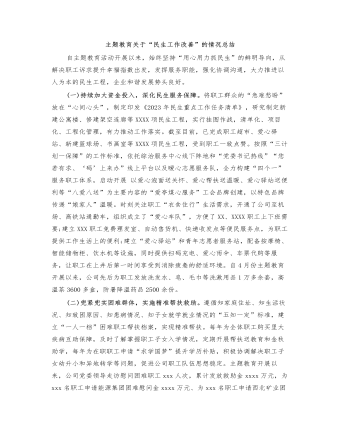
主题教育关于“民生工作改善”的情况总结
扩建了职工洗浴中心,建筑面积达到6000平方米,安装更衣吊篮xxxxxx个,极大地满足了使用需求。修订了浴室管理制度,配齐了浴室服务人员,设立了工作服缝补室,改造了浴室厕所,新增擦鞋机、吹风机、排气扇、淋浴喷头等,确保了基础设施完善到位。突出抓好供水环节监管,加强设备维修维护,确保了水质达标、水量充足、水温适宜、24小时供应。委托xxxxx物业管理有限公司负责浴室日常卫生保洁、工作服及胶鞋收发洗烘、池浴换水等服务工作,为职工提供了更为舒适的洗浴环境;宿舍管理方面。积极改善员工宿舍条件,高层公寓楼实施酒店式管理,让员工实现了“拎包入住”,享受上了“星级服务”。为公寓楼加装电梯,安设了空凋、洗衣机等设备,设置了《人员信息管理看板》,在xxx号、xxx号公寓楼调整建立了xxxx间夫妻房,并安排符合条件的职工入住,对xxxx国际公寓的xxx间探亲访进行了软硬件设施排查,并补齐日常所用家具设备。同时,为职工宿舍配备灭蝇灯、电蚊香等设备,为员工营造出温馨、舒适的居住和生活环境,让员工真正感受到家的温暖。
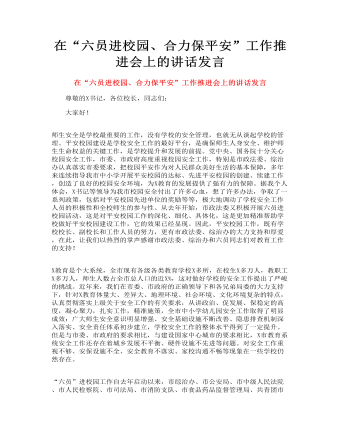
在“六员进校园、合力保平安”工作推进会上的讲话发言
教育是个大系统,全市现有各级各类教育学校X多所,在校生X多万人,教职工X多万人,师生人数占全市总人口的近X%,这对做好学校的安全工作提出了严峻的挑战。近年来,我们在市委、市政府的正确领导下和各兄弟局委的大力支持下,针对X教育体量大、差异大、地理环境、社会环境、文化环境复杂的特点,认真贯彻落实上级关于安全工作的有关要求,从讲政治、促发展、保稳定的高度,凝心聚力,扎实工作,精准施策,全市中小学幼儿园安全工作取得了明显成效:广大师生安全意识明显增强、安全基础设施不断改善、隐患排查机制深入落实、安全责任体系初步建立,学校安全工作的整体水平得到了一定提升。但是与市委、市政府的要求相比,与建设国家中心城市的要求相比,X市教育系统安全工作还存在着城乡发展不平衡、硬件设施不先进等问题。对安全工作重视不够、安保设施不全、安全教育不落实、家校沟通不畅等现象在一些学校仍然存在。

人教版新目标初中英语八年级上册How do you make a banana milk shake教案2篇
1. First, ... then, ... next, ... finally, ...首先,……然后,……接着,……最后,……这是英语中表达做某事的步骤的一种说法。如果步骤较多,还可以说:first-next-after that-later on-finally/at last通常你会听到说英语国家的人在说 first, next, then, finally 和后面的内容时,他们会做一些停顿。这样就能提前告诉听者接下来讲的是一系列的步骤。这一点在朗读和听力中应特别注意。2. how many, how much均为疑问词,同是“多少”,但用法不同。请看:how many修饰可数名词复数,how much修饰不可数名词。但在用法上,同学们常犯如下错误:1) [误] How many are there bananas on the table?[正] How many bananas are there on the table?[析] how many, how much 中的many,much是形容词,常修饰名词作定语,故后面跟名词。2) [误]How much tea are there on the table?[正]How much tea is there on the table?[析] how much修饰不可数名词时,谓语动词用单数。how many与how much的区别可简记为:前how many:问“多少”,复数名词后面跑;how much问“多少”,不可数名词单数好。前者答语用基数词,后者答语用数量关系。

人教版新目标初中英语八年级上册How was your school trip教案2篇
“Go for it!” is based on “Task-Based Language Teaching”. It adheres to “The authenticity principle”, “The form-function principle”, “The task dependency principle” and “The principle of learning by doing”. These principles all accord with the demands of curriculum focus.In and of Grade Seven (II), “Go for it!”, students have learned “The Simple Past Tense”. And it appears again in of Grade Eight (I). teaches students more about how to talk about events in the past. In addition, it gives affirmative and negative statements in the past tense, such as the sentence patterns “Did you see …?” “Were there …?” “Did you go …?” As the first part of Unit 8, Section A opens with a picture presenting the last school trip in the aquarium and continues with several step-by-step practice activities, which are all good for students to master “The Simple Past Tense”. Doing well in Section A will help students integrate the new target language with that in Section B. Thus, they can describe the events in the past freely and foster their own ability of reflecting and practicing. II. Teaching ObjectivesTeaching objective is the beginning and aim of teaching activities. According to the overall goal of the English elementary course--- improve students' synthetic ability of language application, which should be based on the development of students’ “Language knowledge”, “Language skills”, “Character building”, “Learning strategies” and “Cross-cultural awareness”. The teaching objectives are described as follows(I). Knowledge objectivesi. Master the simple past tense of regular and irregular verbsii. Recite the new words and expressions about the last school trip in the aquarium, including their pronunciation and intonation

人教版新目标初中英语八年级上册How do you get to school教案2篇
Step Ⅶ Role play ( Work on 1b)1. First ask two students to read the dialogue to the class.Sa: How do you get to school?Sb: Well, I ride my bike to the subway station. Then I take the subway.2. Now work with a partner.Suppose you use two kinds of transportation to get to school \Hangzhou\Beijing... (bus, train, subway, walking, bike, etc.) Tell how you get there. You may use the phrases in 1a.3. Then ask different pairs of students to present their conversations to the class.Step ⅧListening1. Work on 2a(1) First ask students to read the list of information that Thomas wants to know.…where Nina lives.…how far from school she lives.…how long it takes to get to school.…how she gets to school.…what she thinks of the transportation.(2) Tell students what transportation and bus stop mean.bus stop 汽车站 transportation n. 运送;运输Then tell students we'll hear a recording. Please put a checkmark in front of each thing that Thomas wants to know.(3) Now play the recording for students.( Have students pay attention to the sample answer.) (4) Then correct the answers.

人教版新目标初中英语八年级上册What’s the best radio station教案2篇
教学重点和难点:运用所掌握的语言描述,比较不同地点的特点。在练习中学习掌握英语比较级和最高级的用法。课前准备分配小组,每组五至六人。通过上网或翻阅报刊杂志等方法,确定旅游线路,做出基本的旅游计划。教学设计:本节课流程图 学法指导:1.由于这是一堂新课,在教学中应注意面向全体,发挥学生的主体性,引导学生积极参与,激发学生的求知欲和学习积极性,指导学生积极思维,主动获取知识,养成良好的学习方法。逐步学会独立解决问题。总之要尽可能调动学生的非智力因素促进智力因素的发展。教法选择:1.电化教学法2.课堂讨论法3.任务型教学法采用这些方法的目的是为了充分调动学生的学习积极性,使学生变被动学习为主动学习。通过电脑形象的演示,加强印象,提高兴趣,突破难点,提高教学效率,进而增大教学的容量和信息量。充分体现教师为主导,学生为主体的教学原则。

人教版新目标初中英语八年级上册What’s the matter教案2篇
She shouldn’t go to the party tonight.Step7. TaskT: You know, there are lots of problems in our life. If you are a doctor, please tell us how to solve the problem. I will divide you into 9 groups. Please work in groups. And then choose one of you to report your ideas.The following are the problems:I have a toothache.I am hungry. I have a sore throat.I am stressed out. I have a sore back.I am tired. I can’t sleep.I have a cold. I have a headache.Report: If you have a headache, you should go to bed early. You should see the doctor. You should eat some medicine. You shouldn’t wash your face with cold water.You shouldn’t sleep late.You shouldn’t swim.…..T encourages the students to give advice as much as possible.Homework:1. Chose one of the problems, and write down your advice2. Copy the new words这一步是用于热身的,同时也可以让他们复习一部分的表示人体部位的单词,扩充知识.学习语言的过程也是一个不断积累的过程,复习旧知识,增添新知识.通过小游戏,强化学生对Does she/he have…这个句子的运用能力.通过复习,自然的引到下面新知识的学习。充分利用表格,由句子到对话,再到文章,让学生循序渐进. 提高学生的综合语言运用能力,运用以前学过的知识来解决身边的问题.Period 5 (Section B 3a—3c, selfcheck)教学内容与分析:

人教版新目标初中英语九年级上册Teenagers should be allowed to choose their own clothes教案2篇
Step 1 Greeting Greet the class and check the homeworkStep 2 A duty report The S on duty gives a report on the rules in his home and lead in 3a “Sun Fei’s and Wu Yu’s rules” Step 3 ReadingSs read the conversation and write the two girls’ rules in the chart. Check the answers.Get Ss to read after the tape and then read aloud by themselves. Then, T explains the language points.Step 4 Pairwork 3bRole play. Use the information in chart to practice with the conversation in 3a covered. They can look at the sample conversation in the right box.Step 5 Task 2 “Who’s the best reporter?”Make a survey by asking any 5 students the questions in the chart in activity 4. Then give out a report about it. See who is the best reporter? And the best reporter will get a nice ball-pen.Step 6 Summary and homework:Write out the report in your exercise-books.Period ThreeStep 1 Greeting and a duty reportThe S gives a duty report talking about his experience of being late for school. Lead in the question “Do you ever get to school late? How often do you get to school late? Always, usually, sometimes, or never?Step 2 1a Get Ss to finish writing.Step 3 Pairwork 1b Get Ss to talk about their answers with their partners using the sample conversation in the box on the right.Step 4 Listening practice2a Lead-in: What will happen if you get to school late? What about Peter? Let’s listen to a conversation between Peter and his father. Get Ss to finish 2a (As usual, for the first time, Ss only listen.) Check the answers.

人教版新目标初中英语九年级上册How do you study for a test教案2篇
内容提示本单元主要内容是学会利用verb十by/with gerund表示方式方法来讨论学习英语的策略,认识自己在学习方面的长处和不足。初步了解现在完成时的结构和用法。现在完成时由助动词have/has+动词的过去分词构成,主要表示过去发生的某一动作对现在仍有影响或造成的后果,常与already,yet,just,ever,never等副词连用。教学目标一、学习目标(Language Goal) 1. Talk about how to study . 学会讨论各种学习方法和策略。2. Find out your suitable learning methods. 找出适合自己的学习方法。 二、语言结构(Language Structures) 1. Verb + by with gerund by+动名词短语 表示“通过…途径,方法” 2. How questions have引导的特殊疑问句 三、目标语言(Target Language) 1. How do you study for tests ? 你是怎样准备考试的?Well , I study by working with my classmates. 哦,我和同学们一起学习。2. Have you ever studied with a group ? 你曾经参加过学习小组吗?Yes , I have . I’ve learned a lot that way . 是的,参加过。通过这种方式我学了许多。

人教版新目标初中英语九年级上册Where would you like to visit教案2篇
The First PeriodⅠ.Teaching Aims and DemandsKnowledge Objects(1) Key Vocabularytiring, educational, fascinating, thrilling, peaceful, exotic, trek, jungle, take it easy, explore, historic, site(2) Target LanguageWhere would you like to go on vacation?I’d like to trek through the jungle, because I like exciting vacations.2. Ability Objects(1)Train students to talk about places they would like to visit with the target language.(2)Train students to describe vacations with different adjectives.(3)Train students' listening skill.3. Moral Object,It′s more interesting to go on vacating somewhere instead of staying at home.Ⅱ. Teaching Key Points1. Key Vocabularytiring, educational, fascinating, thrilling, peaceful, exotic, trek, jungle, take it easy, explore, historic, site2. Target LanguageTalk about different places with the target language.Ⅲ. Teaching Difficult Points1. Describe vacations with different adjectives.2. Talk about different places with the target language.Ⅳ. Teaching Methods1. Teaching by illumination2. Teaching by doing chain drills3. Teaching by pairworkⅤ. Teaching Aids1. A tape recorder2. Some pictures of different places with famous views

人教版新目标初中英语八年级上册What are you doing for vacation教案2篇
Teaching goals : 1. Words & phrases: babysit ,get back , fishing , rent , think about , decide(on) , tourist etc. 2. How to talk about future plans . 3. 现在进行时表示将来计划或行动. 4. 特殊疑问句(where , when , how long引导) Important and difficult points : Drills :What are you doing for vacation ? I’m watching TV . When are you going ? I’m going … . How long are you staying ? We’re staying for five days . Teaching aids : cards and a tape ,a large wall calendar . Period 1 Teaching procedures : Step 1Leading in1. Free talk . 2. Put up the wall calendar . T: I’m staying home on Saturday (pointing to next Saturday ).Ss repeat . Ss: I’m staying home on Saturday . T: OK. Today we’ll learn how to talk about future plans. Step 2Pre-task SB Page 13 , 1a . 1. Look at the picture carefully and tell what you see in the picture . 2. Write the activities from the pictures in the box and add some more . 3. Practice reading . Step 3While-task1. Using the activities we write in 1a to make conversations .For example :What are you doing for vacation ? I’m visiting my uncle . 2. Pairwork .Practice in pairs . 3. 用第三人称练习对话.



